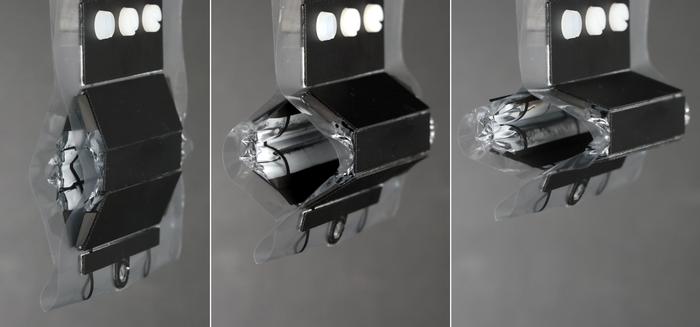Researchers have developed a set of hexagon-shaped robotic components that can be snapped together into larger and larger structures. Each one of the component hexagons is made of rigid plates that serve as its exoskeleton. Driven by electricity, the plates can change their shape, shifting from long and narrow to wide and flat at high speed. The combined structures are capable of jumping four times their own body height, then can shape-shift to roll extremely fast, or use multimodal actuation to crawl through confined spaces.
The robotic components were developed at the Max-Planck-Institute for Intelligent Systems (MPI-IS). The modules are made of six lightweight rigid plates made from glass fiber that form a hexagon. Magnets embedded into the plates allows for quick connection to other components as well as providing a shared electrical ground between the modules.
The design team integrated artificial "muscles" into the inner joints of the hexagons, called hydraulically amplified self-healing electrostatic (HASEL) muscles. Applying a high voltage to the module causes the muscle to activate, rotating the joints of the hexagon and changing its shape from long and narrow to wide and flat.
"Combining soft and rigid components in this way enables high strokes and high speeds. By connecting several modules, we can create new robot geometries and repurpose them for changing needs," said Ellen Rumley, a visiting researcher from the University of Colorado Boulder, in a press release from MPI-IS. Rumley and Zachary Yoder, who are both Ph.D. students working in the Robotic Materials Department, are co-first authors of a new paper, “Hexagonal electrohydraulic modules for rapidly reconfigurable high-speed robots,” published in Science Robotics.
The modules are reconfigurable, with an easy process of attaching or detaching the modules. Chains of modules can be rapidly connected and can operate from one voltage source. The modules can each have their own behaviors, which allows for various operations.
The team created a video to show the various configurations and behaviors that can be created with HEXEL modules. The modules can be seen rolling, dancing, jumping, crawling, and many other motions.
"In general, it makes a lot of sense to develop robots with reconfigurable capabilities," said Yoder. "It's a sustainable design option – instead of buying five different robots for five different purposes, we can build many different robots by using the same components. Robots made from reconfigurable modules could be rearranged on demand to provide more versatility than specialized systems, which could be beneficial in resource-limited environments.''
 Universe Today
Universe Today

